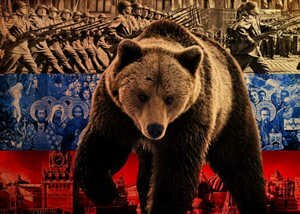
Russia's annexation of the Crimea and its armed aggression against Ukraine have actually removed from the agenda the issue of geopolitical choice of our state, which has finally chose the course of European and Euro-Atlantic integration as the main guarantee of its national security and the driving force of political and economic development.
However, such a strategic choice and its crucial importance for Ukraine require a thorough rethinking of the role of the West and Russia in the world as the two civilizations, and their strategic goals and ways/methods of achieving them.
Undoubtedly, both sides care exclusively about their own interests, providing for the strengthening of their geopolitical positions, widening the circle of allies and partners included.
To achieve this, the United States seeks to demonstrate the benefits of western values to other countries. These are, first of all, respect for democratic norms and human rights, ensuring modern market relations and freedom, as well as transparency of business and the media. Promoting democracy around the world and assisting other countries to achieve it have been declared the mainstay of Washington's foreign policy, supported by the European Union and NATO.
After the collapse of the Soviet Union, the United States and NATO within the framework of such a policy began the process of reducing their military presence in Europe, which peaked in the late 1990s. At the same time, joining NATO by new members from the countries of Central and Eastern Europe and the Baltic States was accompanied by virtually no buildup of armed forces. On the contrary, they were decreased due to their technical modernization and additional capabilities for collective security within the Alliance.
At this, the United States, NATO and the EU's efforts had been reoriented from counteracting threats coming from the East, to the conduct of peacekeeping operations and the fight against international terrorism and totalitarian regimes, threatening both their own populations, and other countries.
Recently, manifestations of this policy have become as follows: peace enforcement of the Slobodan Milosevic regime in the Federal Republic of Yugoslavia, which had provoked the conflict around Kosovo to divert public attention from the authorities' falsifying the presidential elections in the country; antiterrorist operation in Afghanistan against the international terrorist movement “Taliban”; the overthrow of Saddam Hussein's regime in Iraq, which had been using massive “cleansing” of the civilian population of the country for religious and ethnic reasons, and had been planning to develop a nuclear bomb to use it against Israel and Western countries; providing assistance to the opposition forces of Syria and Libya in the fight against bloody dictatorships of M. Gaddafi and B. Assad, and so on.
Currently, the USA and its allies from among the European and Middle Eastern countries have been carrying out an international (coalition) operation to stop the terrorist organization “Islamic State” (IS)'s activity in Syria and Iraq. Besides, the United States and European countries have led a number of other peacekeeping, stabilizing, anti-terrorism (anti-piracy) operations. We can't help pointing out the leading role of the EU and the United States in resolving the situation around Ukraine within the framework of the UN, the OSCE and the negotiation format of the “Norman Four”.
An entirely different approach to the implementation of the foreign policy /geopolitical/ interests is that of the Russian Federation's. Thus, contrary to the democratic principles of the United States and the European Union, the Russian leadership is leading an overtly neo-imperial and neo-colonial policy, masking it under the idea of Eurasian integration and the spread of the so-called Russian world. In order to resume something like the Russian Empire (in particular, in the form of the Eurasian Economic Union / hereinafter referred to as the Eurasian Union/ and CSTO) through bringing to power in the CIS countries /states of the former Soviet Union/ totalitarian and semi-criminal pro-Russian regimes and uniting them around Moscow.
At this, in contrast to the European Union and NATO, based on the principles of voluntary membership and equal rights in the collective decision-making, Russia imposes “allied” relations on former Soviet republics, including using the methods of political, economic (primarily energy) and military pressure, blackmail and provocations.
 Thus, it was for the sake of restoring and ensuring the guaranteed Russia's control over the post-Soviet territories that in the early 1990s, Moscow provoked (or “froze”) armed conflicts in Tajikistan, Moldova /Trans-Dniester/, between Armenia and Azerbaijan /in Nagornyi Karabakh/, in Georgia /Abkhazia and South Ossetia/ with mandatory preservation in the future in their territories of its military presence in various forms and formats (usually artificially contrived and contradicting international law). Besides, in August 2008, Russia resorted to direct military aggression against Georgia, and in February 2014 — it annexed the Crimea and unleashed the armed aggression against Ukraine.
Thus, it was for the sake of restoring and ensuring the guaranteed Russia's control over the post-Soviet territories that in the early 1990s, Moscow provoked (or “froze”) armed conflicts in Tajikistan, Moldova /Trans-Dniester/, between Armenia and Azerbaijan /in Nagornyi Karabakh/, in Georgia /Abkhazia and South Ossetia/ with mandatory preservation in the future in their territories of its military presence in various forms and formats (usually artificially contrived and contradicting international law). Besides, in August 2008, Russia resorted to direct military aggression against Georgia, and in February 2014 — it annexed the Crimea and unleashed the armed aggression against Ukraine.
Russia has always supported and today supports separatists by granting them financial and economic aid, as well as sending into conflict zones its mercenaries and regular units of the Armed Forces (first of all, special task forces) under the guise of “peacekeeping forces”, “militia”, “cossacks”, “volunteers” or “rebels”. Besides, Russia comprehensively provides separatists, supplying them with weapons, ammunition, military equipment and other material and technical means, as well as sending instructors and military experts to them.

In particular, today in the so-called Donetsk and Luhansk People's Republics there are deployed two Army Corps of Russian occupation forces, under the 12th Command of the Reserve of the Southern Military District of the Russian Federation's Armed Forces. The Corps are led and staffed by regular Russian military servicemen, and are equipped with Russian weapons. The total number of the personnel of these units is at least 44-45 thousand people, armed with no less than 700 tanks, 1,5 thousand armored combat vehicles, more than 800 artillery systems and rocket launchers and tactical missiles complexes “Tochka-U” and a wide range of means of air defense.
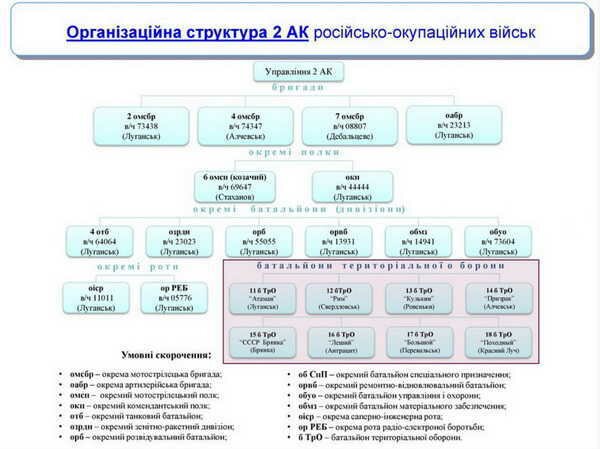
In all cases, Russia goes to outright deployment and building up of its troops in the breakaway republics and occupied territories of other countries, like it takes place in Moldova /Trans-Dniester/, Tajikistan, Armenia, Georgia /Abkhazia, South Ossetia/ and in Ukraine /the Crimea/. In particular, after Russia's occupation of the Crimea, a powerful group of Russian troops, including land, sea and air components totaling to 27 thousand military servicemen (is planned to increase to 45 thousand) has been deployed in the Crimean Peninsula.
In turn, the main direction of Moscow's actions to promote its interests and to deter the United States, NATO and the EU in the rest of the world, is its support for totalitarian regimes of “rogue states”, as well as for all sorts of extremist and terrorist organizations. The main form of this support is providing military-technical, financial and, in some cases, direct military aid.
Russia is the main supplier of arms to Venezuela and Nicaragua, which are its outposts in the Western Hemisphere, and the conductors of the Russian anti-American policy in Central America. Besides, Russia has plans to resume supplies of Russian weapons to Iran (including C-300 air defense systems), which will provide it with greater opportunities for an aggressive policy in the Middle East. In this way, Russia is trying to create a counterweight to the United States in the region and to provoke an aggravation of the situation around Iran in order to prevent the return of Iranian oil to the world market.
Since the beginning of the armed conflict in Syria in 2012. Russia has been the main supplier of weapons to the Syrian regime of Bashar al-Assad, which allows him to continue punitive operations against the insurgents. The range of supply covers a wide range of different (including latest) weapons and military equipment, including small arms ammunition, guns and multiple rocket launchers, armored personnel carriers, communications and intelligence means, and even fighter-interceptors MiG-31. Besides, the parts are delivered to the armored, missile and artillery, aircraft and other equipment that had been transferred to Syria before.
Moreover, recently, due to the significant deterioration of the state of Bashar al-Assad's regime, there has taken place a direct involvement of Russian military personnel and individual units (such as the Marine Corps from the group of Russian troops in the Crimea) in combat actions in Syria on the side of the regime. According to Israeli and Arab sources, there are several thousand Russian citizens in Syria, who perform the functions of advisers and experts on servicing the equipment, guarding Russian military facilities on Syrian territory (first of all the base of the Russian Navy in Tartous) and being used to defend Damascus and the coastal province of Latakia (areas densely populated by Muslims-Alawites — Assad's main supporters).
At the same time, according to the Turkish secret services, Russia is supporting Turkey's Kurdish extremists, who have significantly activated their sabotage and terrorist activities. Thus, Russia is seeking to weaken Turkey as NATO member, as well as to prevent the implementation of European projects of new transport and energy corridors from the Caspian and Central Asian regions, bypassing the Russian Federation through the Turkish territory. Proof of this was the Kurdish terrorists' blowing up in August this year, of the strategically important Baku-Tbilisi-Ceyhan oil pipeline near Turkey's border with Georgia.
Moscow leads purely confrontational policy at a higher level as well as part of Russia's strategy to revive its role as a “great world state”. For example, after V. Putin's return as President of Russia in 2011, Russia suddenly changes its course from the policy of normalizing relations with the West in exchange for loans, and modern technologies — to a confrontation with the United States and Europe, and self-isolation within the chimera of the “Russian world”. This confrontation has become especially sharp since the beginning of the Russian aggression against Ukraine, which has actually brought relations between Russia and the West onto the level of a new “cold war”.
The policy led by Russia is accompanied by vigorous actions to strengthen the grouping of the Armed Forces in the European sector, as well as by a large-scale demonstration of force to the United States and NATO. In particular, in the Western Military District of the Russian Armed Forces, there is being deployed a new 1st Tank Army. Apart from this, the 20th Combined Arms Army is being relocated from Moscow's suburbs closer to the Ukrainian border — into Voronezh region. At the end of 2011 in the Southern Military District of the Armed Forces of the Russian Federation there was formed the 49th Combined Arms Army (with the Headquarters in Stavropol) specially for actions in the Ukrainian (Azov-Black Sea) operational direction, the main units of which are located in the Stavropol Territory. Besides, Russia is threatening with possible deployment in Kaliningrad region of the RF and in the Crimea of tactical missile systems “Iskander” and with targeting them to the US and NATO facilities in the Baltic countries and Poland.
 Certain efforts have been made to expand the Russian military presence outside its national territory through deployment of military bases, points of basing and other objects of the Russian Armed Forces in other countries. Such bases are already in Armenia, Tajikistan and Kyrgyzstan. Today they are planning to deploy another Russian air base in Belarus and to modernize the point of logistics of the Russian Navy in the Syrian port of Tartus. They also are considering questions of placing new missile warning systems in Azerbaijan, as well as of creating or restoring the points of basing of the Navy and the Russian Air Force in Egypt and Vietnam.
Certain efforts have been made to expand the Russian military presence outside its national territory through deployment of military bases, points of basing and other objects of the Russian Armed Forces in other countries. Such bases are already in Armenia, Tajikistan and Kyrgyzstan. Today they are planning to deploy another Russian air base in Belarus and to modernize the point of logistics of the Russian Navy in the Syrian port of Tartus. They also are considering questions of placing new missile warning systems in Azerbaijan, as well as of creating or restoring the points of basing of the Navy and the Russian Air Force in Egypt and Vietnam.
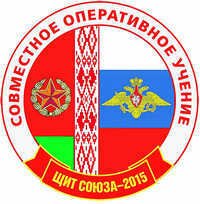 Along with this, there have been significantly stepped up activities on operational and combat training of the Armed Forces, of openly provocative and offensive (aggressive) character included. In particular, in August-September this year, in Russia, there has been held a series of large-scale exercises of the Armed Forces, as well as joint military activities with Russia's allies, including exercises of the Collective Rapid Reaction Forces of the CSTO Interaction-2015, joint Russian-Belorussian trainings Union's Shield-2015, strategic command-and-staff trainings of the Russian Armed Forces Center-2015.
Along with this, there have been significantly stepped up activities on operational and combat training of the Armed Forces, of openly provocative and offensive (aggressive) character included. In particular, in August-September this year, in Russia, there has been held a series of large-scale exercises of the Armed Forces, as well as joint military activities with Russia's allies, including exercises of the Collective Rapid Reaction Forces of the CSTO Interaction-2015, joint Russian-Belorussian trainings Union's Shield-2015, strategic command-and-staff trainings of the Russian Armed Forces Center-2015.
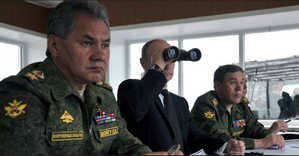 Within the framework of preparations for the trainings Center-2015, at the beginning of this year there was a spot check of combat readiness and combat capability of the troops of the Central Military District of the RF Armed Forces with participation of the Command of the airborne troops and military transport aviation of the Russian Air Force, as well as of units of tactical aviation of other military districts. Similar events were held on the eve of Russia's armed aggression against Ukraine.
Within the framework of preparations for the trainings Center-2015, at the beginning of this year there was a spot check of combat readiness and combat capability of the troops of the Central Military District of the RF Armed Forces with participation of the Command of the airborne troops and military transport aviation of the Russian Air Force, as well as of units of tactical aviation of other military districts. Similar events were held on the eve of Russia's armed aggression against Ukraine.
Besides, this year, have been significantly intensified provocations against the Baltic countries and North-Western Europe, including violation of their air and sea borders by Russia's combat aircrafts, submarines and warships. Provocative flights of Russian aircrafts (including strategic bombers Tu-22M3 and Tu-95M) on a regular basis are also observed in the Black Sea region.
Against this background, Moscow resorts to direct nuclear blackmail against the West. The Russian Federation, seeking to compensate for the weakness of its conventional Armed Forces, has significantly lowered the criteria for the use of nuclear weapons. According to representatives of the military-political leadership of the Russian Federation, including Putin himself, Russia will not hesitate to use nuclear weapons to protect its interests. Thus, the new edition of the Military Doctrine of the Russian Federation (Russian President V. Putin signed the Decree in late December 2014) permits the use of nuclear weapons in case of a non-nuclear war, if there is a threat to the existence of the state. And it's more than just words: Moscow has repeatedly stated that it is able and is ready to use nuclear weapons, even in a limited war.
Such intentions are supported by the Kremlin's activities to implement a comprehensive program of rearmament of the Armed Forces with giving the priority to missile and nuclear forces. In particular, in 2015 they are planning to supply the missile and nuclear forces with up to 40 new intercontinental ballistic missiles. From 2023 on, they are going to resume production of strategic missile-carrier bomber of the latest modernization Tu-160M2.
Large-scale rearmament programs are being implemented in other kinds of the Russian Armed Forces. At this, despite the acute problems of the Russian economy, Russia continues to increase military spending while reducing the amount of financing of programs of economic development and welfare of its citizens.
Such Moscow's actions provoke directly a global armed conflict of the world level, including with use of nuclear weapons. That is, Putin's personal ambitions (as the new “Emperor of All Russia”) pose a real threat to all mankind. As evidenced by the Russian history, political goals and ambitions of the Kremlin under any regime in the country has always prevailed over the universal values of civilization, first of all inclusive with life of its own population, let alone the population of other countries.
This is evidenced by the consequences of Russia's actions to provoke and support armed conflicts on the territories of the former USSR, including with mass civilian casualties and destruction of infrastructure in the combat zone. Since the beginning of the armed conflict in the occupied by Russia territories of the Donbas, at least 8 thousand people have been killed (both military and civilian), and at least 18 thousand people have been injured; the number of refugees from the Donbas has reached 1.8 million people; more than half of industrial and transport enterprises (objects) have stopped functioning; more than 1.2 thousand of apartment blocks and 3.3 thousand private buildings have been destroyed.
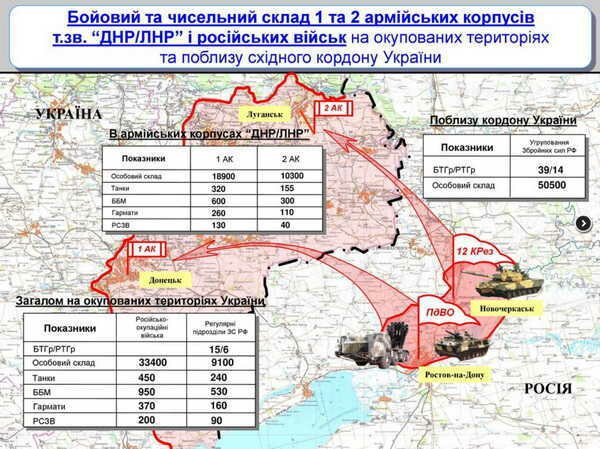
Extremely complicated is the situation in the occupied by Russia territories of Georgia, namely: in Abkhazia, which has completely lost its resort value and turned into a gray criminal zone, and in South Ossetia, which has been left by the majority of the local population (30 thousand persons out of 45 thousand that had lived in its territory before Russia's aggression against Georgia in August 2008).
Russia is destroying its own population too. According to a special parliamentary commission of the Russian Federation, about 120 thousand peaceful citizens of the Russian Federation were killed in the two Chechen wars provoked by the Kremlin.
All this confirms once again the classic and quite accurate statements of US President Ronald Reagan on the Soviet Union as an “evil empire”, the attributed to the first head of the Soviet Russia V. Lenin words about Russia as a “prison of peoples” and the founders of communism, Karl Marx’ and Friedrich Engels’ evaluation of Muscovia’s policy (Russia, the Russian Empire) as a “Moscow-Asiatic barbarism”.
It is well known what happened to the Russian Empire in 1917 and the Soviet Union — in 1991. What will the history of today's Putin's Russia end in? As the saying goes, no need to go to a fortune-teller…

